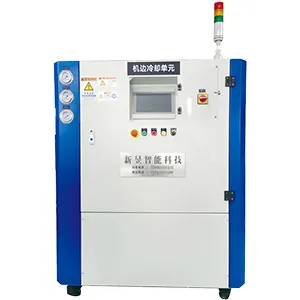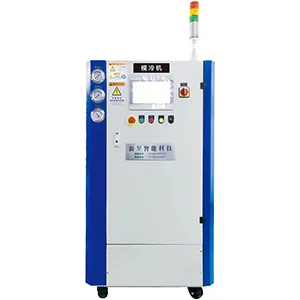In the die casting production process, the cooling system for temperature control refers to a specialized subsystem used to regulate the temperature of molds, die cast workpieces, and related equipment. Through the circulation of media (such as water, oil, or special coolants), it absorbs, transfers, and dissipates heat, ensuring that the die casting process always remains within the preset temperature range. It is a core component of the die casting temperature control system, directly related to mold thermal balance stability, workpiece forming quality, and production efficiency. It is the key equipment for solving the fundamental challenge in die casting: after high-temperature molten metal is injected into the mold, rapid cooling is required for shaping, while avoiding mold cracking caused by excessive temperature differences.
From the perspective of working logic, the system achieves temperature control through the closed-loop process of “heat collection – medium transfer – heat release – medium return.” First, the cooling medium (such as industrial pure water or heat transfer oil) flows through the preset cooling channels inside the mold, absorbing the large amount of heat generated after molten metal is injected into the mold and workpiece. Then, the heat-carrying medium is delivered through pipelines to the cooling unit (such as radiators, cooling towers, or chillers), where the heat is dissipated into the external environment by air or water cooling methods. Finally, the cooled medium flows back into the mold’s circulation channels, completing one cycle of temperature control and continuously maintaining the mold temperature within the appropriate process range (for example, commonly 50–180℃ for aluminum die casting, subject to adjustment according to material and structure).

The die casting mold cooling unit from Xinyu Intelligent Technology is a dual-pressure output device that integrates spot cooling and standard cooling functions.

The die casting spot cooling machine is equipment developed for localized mold temperature control, mainly used for cyclic cooling of specific mold areas during casting, especially for high-pressure spot cooling of ultra-thin core pins.

This die casting mold cooling machine is developed for die casting mold cooling to solve product defects caused by local overheating during the die casting production process.
In the die casting of automotive engine blocks and cylinder heads, precise temperature control systems are critical.
For aluminum housings of smartphones and tablets, extremely high demands are placed on surface quality and dimensional accuracy.
In aerospace, key parts such as aircraft engine blades require extremely strict mold temperature control.
In the production of large integrated die castings such as automotive body frames for new energy vehicles, an advanced mold temperature control system enabled uniform and precise control of large molds.
Conduct regular inspections, replace worn parts promptly, and follow a maintenance plan covering cleaning, lubrication, and calibration.
Check the temperature sensor, then verify heating and cooling systems, and review control settings. Compare normal operation data with current readings to locate anomalies.
Optimize channel design, position heating/cooling pipes strategically, and use effective heat-transfer media. For large molds, apply zoned temperature control for independent regulation.
Use energy-efficient equipment, set reasonable temperature ranges, and reduce heating/cooling during non-production periods (e.g., standby mode).
Consider mold material, product process requirements, and production experience. For example, with aluminum alloy die casting, adjust parameters according to alloy grade and structure.









